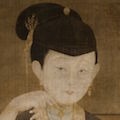GALLERY 2600 | EAST ASIAN ART
 As subjects in Chinese and Korean paintings, women appear in numerous guises—from deities and mothers to court ladies and courtesans. The goal of figure painting in East Asia was not the celebration of the human form, as it was in Western art, but the presentation of paragons of wisdom and virtue whose noble deeds and lofty attainments might inspire emulation.
As subjects in Chinese and Korean paintings, women appear in numerous guises—from deities and mothers to court ladies and courtesans. The goal of figure painting in East Asia was not the celebration of the human form, as it was in Western art, but the presentation of paragons of wisdom and virtue whose noble deeds and lofty attainments might inspire emulation.
The earliest Chinese paintings of female figures were didactic in nature, illustrating exemplary women engaged in duties and activities appropriate to their designated station in life according to patriarchal Confucian principles. By the Tang dynasty (618–907), a growing interest in the depiction of daily life in the palace led to the establishment of a new category of painting that portrayed beautiful women. Images of elegant court ladies engaged in leisure activities were especially popular—the dignified female figures represented in these paintings served not as specific portraits, but rather as pictorialized types that reflected contemporary standards of feminine beauty.
Paintings of women with fanciful coiffures, perfect complexions, and luxurious silk dresses continued to be made through the succeeding dynasties, but with relatively little scholarly attention paid to them. Such works were dismissed as decorative and less significant when compared to the expressive and calligraphic forms of literati painting. Although landscapes and literati subjects would remain the preeminent focus of East Asian painting through the Qing dynasty (1644–1911) in China and Chosŏn dynasty (1392–1910) in Korea, the repertoire of female imagery in poetry, literature, mythology, and history provided a rich source of inspiration for East Asian artists.
Drawn from the permanent collection, this gallery installation presents works focused on female subjects, including mythical goddesses, aristocratic beauties, and commoners. The settings, hairstyles, costumes, and accoutrements that surround these female figures often provide the visual clues necessary to determine the woman’s identity or social rank. A careful examination of the pictorial details in the paintings thus rewards the viewer with a wealth of visual information to help in the interpretation of these works.
June 2016 – Dec 2016





